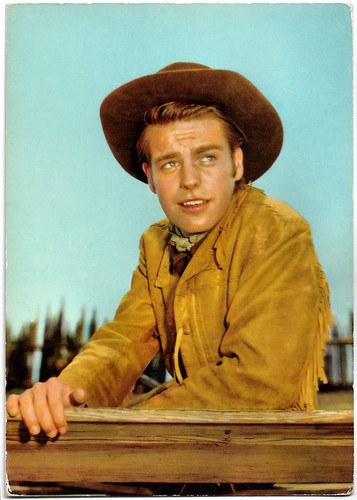
Italian postcard by Rotalfoto, Milano, no. 31. Photo: Robert Wagner in White Feather (Robert D. Webb, 1955).
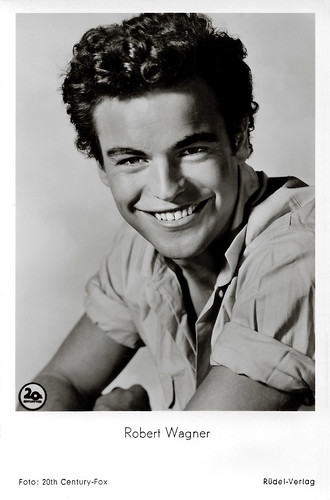
West-German postcard by Rüdel-Verlag, Hamburg-Bergedorf, no. 1257. Photo: 20th Century-Fox. Robert Wagner in Prince Valiant (Henry Hathaway, 1954).
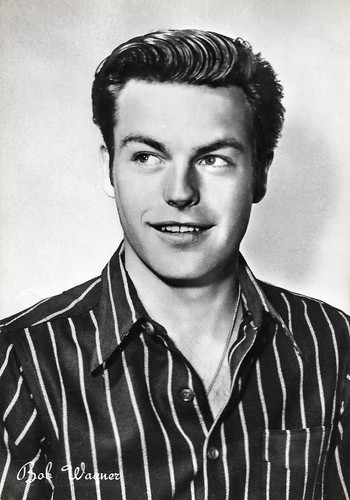
Italian postcard by Rotalfoto, Milano, no. 401.
Unable to make the transition to top-level star
Robert John 'R.J.' Wagner was born 1930 in Detroit. He is the son of Hazel Alvera (née Boe), a telephone operator, and Robert John Wagner Sr., a traveling salesman who worked for the Ford Motor Company.
His family moved to Los Angeles when he was seven. Wagner attended and graduated from Santa Monica High School in Santa Monica, and attended military academies and Harvard. Always wanting to be an actor, he held a variety of jobs while pursuing his goal.
After making his uncredited screen debut in The Happy Years (William A. Wellman, 1950), he was signed by agent Henry Willson. He was put under contract with 20th Century-Fox, which carefully built him up toward stardom.
He played romantic leads with ease, but it was not until he essayed the two-scene role of a shell-shocked war veteran in With a Song in My Heart (Walter Lang, 1952) starring Susan Hayward, that studio executives recognised his potential as a dramatic actor.
He supported James Cagney and Dan Dailey in John Ford's version of What Price Glory (1952) and supported Clifton Webb and Barbara Stanwyck in Titanic (Jean Negulesco, 1953).
Fox gave Wagner his first starring role in Beneath the 12-Mile Reef (Robert D. Webb, 1953) with Terry Moore and Gilbert Roland. The screenplay by A.I. Bezzerides was inspired by 'Romeo and Juliet' by William Shakespeare. Reviews were poor but the film was only the third ever to be shot in CinemaScope and was a big hit.
Wagner went on to play the title roles in Prince Valiant (Henry Hathaway, 1954) opposite James Mason and Janet Leigh, and The True Story of Jesse James (Nicholas Ray, 1957), with Jeffrey Hunter. He portrayed a ruthless college student, who resorts to murder in an attempt to marry an heiress (Joanne Woodward) in A Kiss Before Dying (Gerd Oswald, 1956). The latter two films were box office disappointments and it seemed Wagner was unable to make the transition to top-level star.
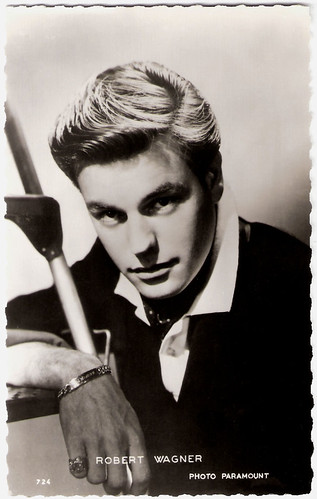
French postcard by Editions P.I., Paris, offered by Les Carbones Korès Carboplane, no. 24 H. Photo: Paramount, 1956.
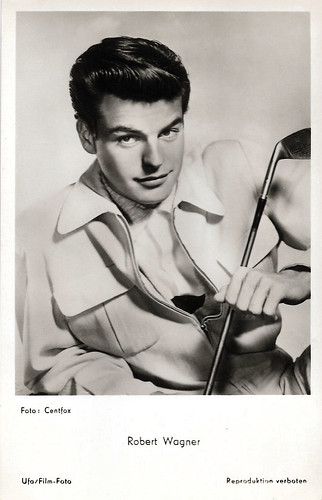
German postcard by Ufa/Film-Foto, Berlin-Tempelhof, no. FK 3512. Photo: Centfox.
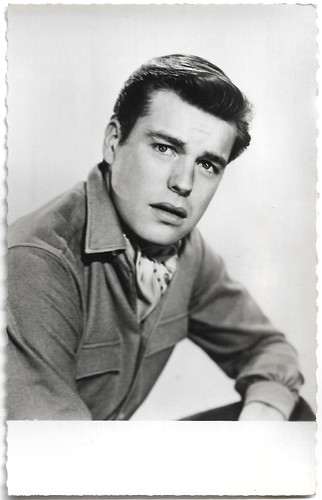
French postcard by Editions P.I., Paris, no. 998. Photo: Robert Wagner in The Mountain (Edward Dmytryk, 1956).
A respectable transition to television
In Europe, Robert Wagner had a small role in the epic war film The Longest Day (Ken Annakin, a.o., 1962), produced by Daryl Zanuck for Fox. He had a larger part in The Condemned of Altona (1962), a commercial and critical disappointment despite being directed by Vittorio de Sica and co-starring Sophia Loren.
In the mid-1960s, Robert Wagner's film career skidded to a stop after the massive hit The Pink Panther (Blake Edwards, 1963) with David Niven, Peter Sellers, and Claudia Cardinale. Blake Edwards wanted Wagner for the lead in The Great Race (1965), but Jack L. Warner overruled him.
Wagner found a good supporting role in the modern-day private investigator hit, Harper (Jack Smight, 1966), starring Paul Newman. He signed with Universal Pictures in 1966, starring opposite future wife Jill St. John in the films How I Spent My Summer Vacation/Deadly Roulette (William Hale, 1967), and Banning (Ron Winston, 1967).
He returned to Italy to make a caper film with Raquel Welch for MGM, The Biggest Bundle of Them All (Ken Annakin, 1968), but it was not a success.
Wagner made a respectable transition to television as the star of the lighthearted espionage series It Takes a Thief (1968) with Fred Astaire. He also starred in the police series Switch (1975) with Eddie Albert and Sharon Gless.
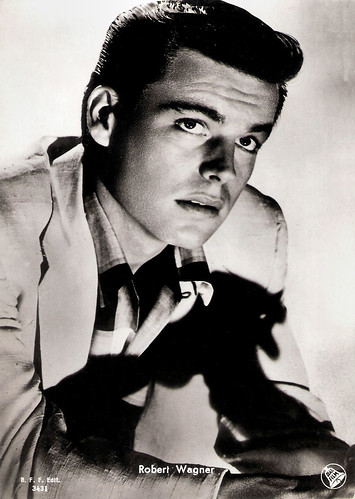
Italian postcard by B.F.F. Edit., no. 3431. Photo: Dear Film. Robert Wagner in A Kiss Before Dying (Gerd Oswald, 1956).
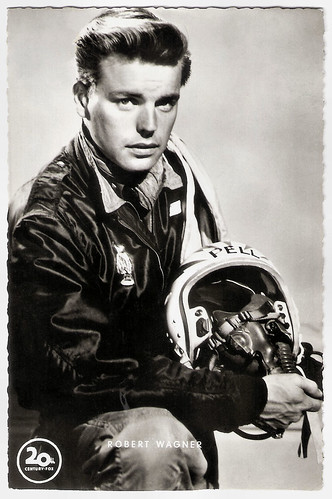
German postcard by Kunst und Bild, Charlottenbrug. Photo: 20th Century Fox. Robert Wagner in The Hunters (Robert D. Webb, 1958).
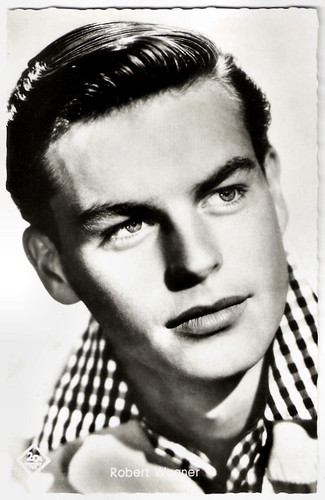
West-German postcard by Kolibri-Verlag, G.m.b.H., Minden/Westf., no. 1582. Photo: 20th Century Fox.
One of Hollywood's nicest citizens
Robert Wagner's greatest success was opposite Stefanie Powers on the internationally popular TV series Hart to Hart (1979), which ran from 1979 through 1984 and has since been sporadically revived in TV-movie form. Another series, Lime Street (1985-1986), was quickly canceled due to the tragic death of Wagner's young co-star, Samantha Smith.
Considered one of Hollywood's nicest citizens, Robert Wagner has continued to successfully pursue a leading man career; he has also launched a latter-day stage career, touring with Stefanie Powers in the readers' theater presentation 'Love Letters'. He also had a recurring role as Teddy Leopold on the TV sitcom Two and a Half Men (2007-2008) and had a recurring role as Anthony DiNozzo Sr. on the police procedural NCIS (2010-2014).
In the cinema, Wagner played Number Two, a henchman to Dr. Evil opposite Mike Myers in Austin Powers: International Man of Mystery (Jay Roach, 1997) and its sequels, Austin Powers: The Spy Who Shagged Me (Jay Roach, 1999) and Austin Powers in Goldmember (Jay Roach, 2002).
In 2008, Wagner published his autobiography 'Pieces of My Heart: A Life', written together with author Scott Eyman. Robert Wagner says in his autobiography that he had a four-year relationship with Barbara Stanwyck who was more than twenty years older than he was. He says she was his first great love and that she gave him more than any woman in his life.
Robert Wagner married four times. He married Natalie Wood twice (1957-1962) and (1972-1981 - her death). In between, he was married to Marion Marshall (1963-1971). Since 1990, he is married to actress Jill St. John. He has known her since 1959, and they've been a couple since 1982, eight years before their wedding.
Robert Wagner is the father of Katie Wagner (1964) with Marion Marshall and Courtney Wagner (1974) with Natalie Wood. Though the double surname suggests otherwise, he never legally adopted his ex-stepdaughter Natasha Gregson Wagner. In 2006, he became a grandfather when his daughter Katie Wagner gave birth to her son, Riley John.
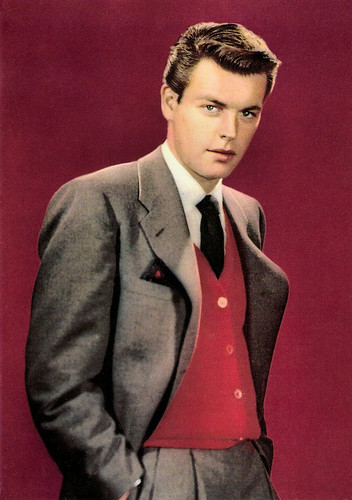
Italian postcard by Rotalfoto, Milano, no. 26.
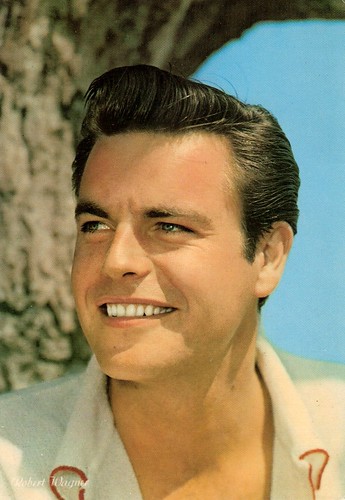
Italian postcard in the series Artisti di Sempre by Ed. ris. Rotalfoto S.p.A., Milano, no. 287.
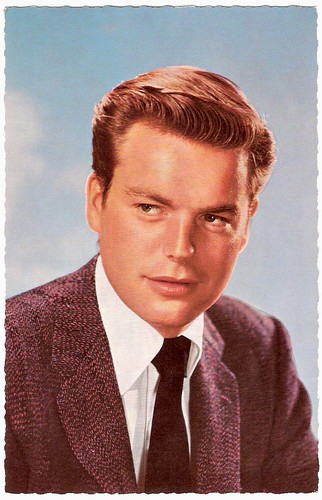
German postcard by Kunst und Bild, Berlin-Charlottenburg, no. CD4.
Sources: Wikipedia and IMDb.
No comments:
Post a Comment